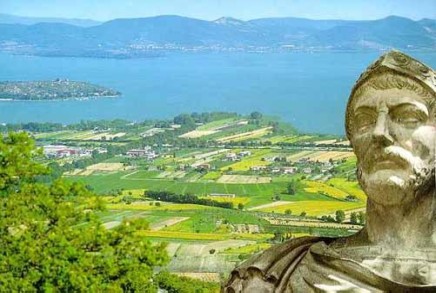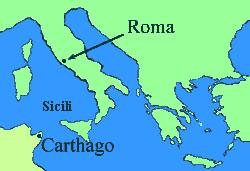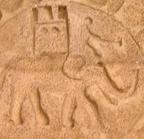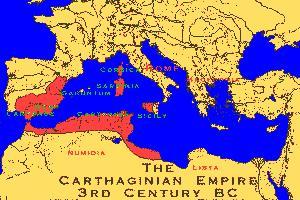The First Punic War began because of a proxy war with two Sicilian cities.
This proxy war involved Syracuse and Massena, and was fought on a smaller level.
Massenean people (mercenaries) wanted to take the King of Syracuse (King
Hiero II) out of power. This proxy war developed into something much greater.
As alliances, Carthage took the side of Massena and Rome took the
side of Syracuse. This began the uprising into a much larger war between
that of Carthage and Rome. This was the foundation for the beginning of the
First Punic War in 264 B.C. The Romans were nervous that the Carthaginians
were gaining too much power, especially in that of Sicily. Since Sicily
was close to mainland Italy, there was not much of a buffer zone between
the two civilizations. The Romans thought it was necessary to finally
gain some assertiveness and left Italy to fight in Sicily against the Carthaginians.
Unaware of what the war might bring, the Romans began to deploy ground
forces by means of Roman warriors. They were however, substantially out numbered on the sea. Their naval forces at the time were very small in comparison to the Carthaginians. In an attempt to build their naval fleet the Romans assembled 120 new ships in a matter of 60 days. These ships were built to fight the Carthaginians on the seas. In addition, they were designed to break or destroy another ship if hit just right, basically they could cause vast damage to another boat and ultimately the other boats would sink from gaining too much water. They also had vessels with crows that made it possible to board an enemy’s boat. On the ground in Sicily M. Valerius and M. Otacilius Crassus lead the Roman army through numerous Carthaginian towns conquering them as they went. Now it’s important to point out that at this time Rome had a senate that had influence over their political and social affairs. The senate was leery about the Punic War from the start. However, after having some successful victories they began to support the cause. As the Romans started to sweep Sicily, they imposed impossible standards on the Carthaginians. From 264 to 256 B.C. the Romans won both on land and at sea. However, in 255 B.C. the Carthaginians hired a Spartan man named Xanthippus who was a general for the Spartans. At the Battle of Bagradas, Xanthippus along with the Carthaginians and war elephants beat the Roman army so badly that of the 20,000 Romans who were fighting only 2,000 survived and were forced out of Sicily. The Romans were then forced to take up the coastal waters of Africa. In 254 B.C. the Romans lost nearly 70% of their boats due to bad storms; the boats were smashed up against rocks and destroyed. But the Romans proceeded to move on and in 252-250 B.C. Publius Claudius Pulcher and a new fleet of 123 ships went back into Sicily and began to attack the Carthaginians again. In 247 B.C a man named Hannibal began an attack on the Romans that lasted 4 years and the Roman again were losing. The Romans along with the senate were getting exhausted but in one last effort they built 200 more ships and put in charge C. Lutatius Catulus. In 241 B.C. the Romans final won over Sicily and beat the Carthaginians. After this period they put many restrictions and Carthaginians and made them pay 3,200 gold talents over a course of 10 years. The First Punic War was one of the greatest army and naval battles of its time. There was a vast amount of resources that went into this war. The First Punic War later lead into the Second and Third Punic Wars as the cost, control, and power were in the hands of the Romans and the Carthaginians wanted that back and to seek revenge. |

The First Punic War: An Analysis by Joseph Ramsay & Paul Schroepfer |
The First Punic War was one of the greatest wars in the ancient world. This
war was between the Romans and Carthaginians for the control of Sicily.
There is vast importance and significance given to this war specifically because
it showed the rest of the world that the Romans were contenders for power and
wealth. The Romans before the First Punic War were not the dominate power
in the ancient Mediterranean. At this time in 264 B.C. they were a developing
society. The First Punic War began in 264 B.C. and ended in
241 B.C. a war that lasted almost a quarter of century in length; it truly tested
the power of the Romans. This war was the foundation for the rise in Roman
authority over the Mediterranean. After the Punic Wars, Rome forever
changed socially, politically, and culturally. It’s imperative to analyze
and evaluate the Punic Wars in terms of historical significance, and to how they
shaped the modern world. Furthermore, the focus of this presentation
will be to look specifically at the First Punic War and how civilizations of this
time were forever altered as a result to this war. Additionally, there
are certain sequences of events that one must look at to help guide the understanding
of the war. The events leading up to the war, events throughout the
first war, and the aftermath of the war are important to comprehend as
they changed the course of the Second and Third Punic Wars, as well as the course
of history. |
Summary: |
Introduction: |
First Site Analysis: |
In an analysis of one really good website, I found the website [http://www.unrv.com/empire/first-punic-war.php] to have substantial information and detail. This website offered what looked
to be a step-by-step account of each specific battle that took place. It walked
the reader from the beginning of the war in 264 B.C., and the details of the
proxy war that took place, all the way to the end where Rome finally gains conquest
over Sicily and defeats the Carthaginian army in 241 B.C. The websites
far exceeds the quality of that of other websites. This site offers
a large amount of detail and links that one can click to read more information.
For example, if one were reading about C Lutatius Catulus and him taking
the Romans to victory in 241 B.C. one could click a link to his name and begin
reading more about him. This to me this shows that the website really
wants to educate and expands upon the information. Additionally this
site offers a whole photo gallery of Roman art, architecture, and sculpture indicative
of the time. This gallery is part of the national geographic page.
What gives this website more credibility over other websites is the overall balance of the website. It gave a detailed account of the how the war proceeded to take place; it gave numerous pictures, as well as links for other information and people fighting in the war. Specifically, this website offered information about the ship building that other websites did not incorporate. They talked about the lead up to the First Punic War that other websites did not include. Furthermore, they talked about the Roman ships and how they were destroyed on the coast of Africa. The other websites that were found had short bits of information or no information at all on some of these events. They tended to be incomplete in terms of information, historical significance, pictures, and integrity. There are all kinds of websites out there that offer information, but the reader must have a fair sense of what to trust and what not to trust when it comes to research and evaluation of sites. Moreover, this website did not only talk about the First Punic War and its effects, it also talked about Roman History in general and that of the Second and Third Punic Wars. This enhances the overall educational process by which someone might like to know about in these consecutive wars. In guiding the reader from one war to the next, there is a real sense of expansion of knowledge. This knowledge was not given by most other websites, so in final evaluation, this website seemed to be one of the best. |
Second Site Analysis: |
A second website that was visited was [http://www.crystalinks.com/punicwars.html]. This site was one that seemed to have a good analysis of the Punic Wars in general. I was impressed by the photo that was placed on the top, which I've added here: |
The picture just captured a scene of two great armies meeting on the field of battle
for domination of the Mediterranean world. I was also drawn to the website
with its explanation of the name of the wars, with Punic coming from the
Latin punici, which was Rome's name for the Carthaginians. This name is turn
came from the older Poenici, which was Latin for Phoenician, who were the forbears
of the Carthaginians. The website also does a good job of succintly pointing out the factors in play which helped launch the First Punic War. It talks about the interplay between the proxies and how they in turn helped the two great powers come into inevitable conflict. The naval side of the conflict is also covered well by this website. The corvus, or boarding device of the Romans, is explained and it is shown how it directly led to the turning of the tide of the war at sea. The importance of the naval conflict is also evident from the website's commentary. The aftermath is also given its fair due on this website. The results of the war are explained well. Also, the fact that the First Punic War was the birth of the Roman navy was importantly pointed out as well. Aftermath of the conflict continues on on the website with commentary on the other Punic Wars. |
Conclusion: |
The First Punic War truly was the beginning of the end for the Roman Republic, and
the beginning of the rise of the Roman Empire. Prior to the outbreak of
the war in 264 B.C., the Romans were limited to fighting other Italians.
However, they had done this methodically and had grown as a nation in the process.
By the time of the war, Rome was ready to make its move. Carthage was the recognized naval power of the day. Rome was forced into the seas by the wars. By the end of the Punic War saga (146 B.C.), however, Rome would be master of sea and land. Carthage was burned to the ground, and as the story goes, sown with salt so that nothing may ever grow there again. The Punic Wars truly do offer us a glimpse at how Rome came to rule the known world. They made a city-state into an empire. Through study of sources such as the websites mentioned and others, we can truly learn the message that is in store for us from the Punic Wars, and we can take it to heart. |
Pictures: |







Sources: |
Crystalinks. Last Update 2007. “Punic Wars – Crystalinks.” Website [http://www.crystalinks.com/punicwars.html] UNRV History: The Roman Empire. Last Update 2007. “The First Punic War.” Website [http://www.unrv.com/empire/first-punic-war.php] |